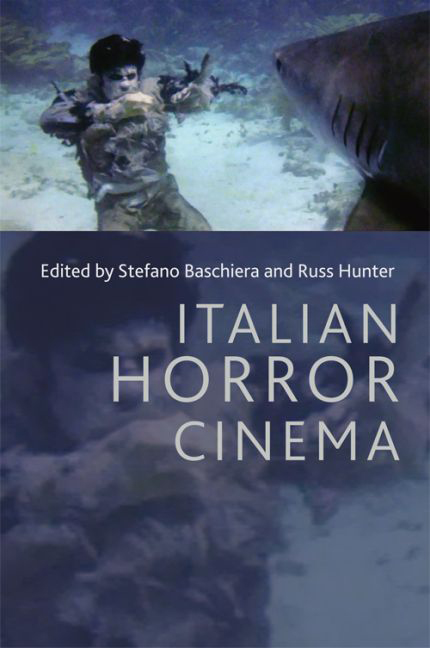Book contents
- Frontmatter
- Contents
- List of figures
- List of contributors
- Acknowledgements
- Introduction
- 1 Preferisco l'inferno: early Italian horror cinema
- 2 Domestic films made for export: modes of production of the 1960s Italian horror film
- 3 The 1980s Italian horror cinema of imitation: the good, the ugly and the sequel
- 4 Knowing the unknown beyond: ‘Italianate’ and ‘Italian’ horror cinema in the twenty-first century
- 5 Bavaesque: the making of Mario Bava as Italian horror auteur
- 6 The Argento Syndrome: aesthetics of horror
- 7 Scrap metal, stains, clogged drains: Argento's refuse and its refusals
- 8 The giallo /slasher landscape: Ecologia del delitto, Friday the 13th and subtractive spectatorship
- 9 Kings of terror, geniuses of crime: giallo cinema and fumetti neri
- 10 Political memory in the Italian hinterland: locating the ‘rural giallo’
- 11 The horror of progressive rock: Goblin and horror soundtracks
- 12 ‘The only monsters here are the filmmakers’: animal cruelty and death in Italian cannibal films
- 13 Italian horror cinema and Italian film journals of the 1970s
- Index
2 - Domestic films made for export: modes of production of the 1960s Italian horror film
Published online by Cambridge University Press: 12 September 2017
- Frontmatter
- Contents
- List of figures
- List of contributors
- Acknowledgements
- Introduction
- 1 Preferisco l'inferno: early Italian horror cinema
- 2 Domestic films made for export: modes of production of the 1960s Italian horror film
- 3 The 1980s Italian horror cinema of imitation: the good, the ugly and the sequel
- 4 Knowing the unknown beyond: ‘Italianate’ and ‘Italian’ horror cinema in the twenty-first century
- 5 Bavaesque: the making of Mario Bava as Italian horror auteur
- 6 The Argento Syndrome: aesthetics of horror
- 7 Scrap metal, stains, clogged drains: Argento's refuse and its refusals
- 8 The giallo /slasher landscape: Ecologia del delitto, Friday the 13th and subtractive spectatorship
- 9 Kings of terror, geniuses of crime: giallo cinema and fumetti neri
- 10 Political memory in the Italian hinterland: locating the ‘rural giallo’
- 11 The horror of progressive rock: Goblin and horror soundtracks
- 12 ‘The only monsters here are the filmmakers’: animal cruelty and death in Italian cannibal films
- 13 Italian horror cinema and Italian film journals of the 1970s
- Index
Summary
Along with the Italian Western, but with an arguably more lasting effect, Italian horror cinema of the 1960s has contributed significantly to the branding of European genre cinema for an international audience. As with Italian cinema a decade earlier, the success of Italian horror film was due at the same time to its compatibility with other, foreign genre products – they could fit in a double bill with an American International Pictures release, for instance – and their perceived ‘otherness’ in respect of the Hollywood standards. In fact, because of their graphic violence, eroticism and visual flair, these films soon gained a cult following outside of Italy, and especially throughout the 1970s with the increasing international success of Italian giallo and with the emergence of horror cult directors like Dario Argento and Lucio Fulci.
However, when viewed from the perspective of Italian film history, the very existence of an Italian horror genre seems to be inexplicable. As many historians have pointed out in the past, this genre seems to have flourished in a country completely devoid of a tradition of domestic gothic or mystery literature. Moreover, the supposedly non-industrial quality of these films, which apparently relied only on the craftsmanship of talented directors like Mario Bava, Riccardo Freda and Antonio Margheriti, contrasts with the idea of an industrial strategy aimed at conquering foreign markets, especially because no Italian company at the time was capable of controlling the international distribution of its products. Finally, Italian horror films were often regarded as completely unrelated to other products of the Italian cultural industry.
While not completely untrue, over the last decade these remarks have been substantially challenged by new works focusing on the complex relationship that 1960s Italian horror entertains with Italian national culture, and on an in-depth analysis of post-Second World War Italian genre cinema. In fact, 1960s Italian horror was indeed a minor genre, which generated modest revenues on the domestic market, and that was highly dependent on an international market model. However, from an industrial standpoint, these films appear to be a product of the new situation that the Italian film industry had been facing since the late 1950s, which somehow helped the acquisition of a brand value in the international circuits on the part of both art and popular Italian cinema.
- Type
- Chapter
- Information
- Italian Horror Cinema , pp. 30 - 44Publisher: Edinburgh University PressPrint publication year: 2016



